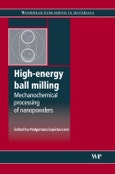Mechanochemical processing is a novel and cost effective method of producing a wide range of nanopowders. It involves the use of a high energy ball mill to initiate chemical reactions and structural changes. High energy ball milling: Mechanochemical processing of nanopowders reviews the latest techniques in mechanochemistry and how they can be applied to the synthesis and processing of various high-tech materials.
Part one discusses the basic science of mechanochemistry with chapters on such topics as the mechanism and kinetics of mechanochemical processes, kinetic behaviour in mechanochemically-induced structural and chemical transformations and materials design through mechanochemical processing. Part two reviews mechanochemical treatment of different materials including synthesis of complex ceramic oxides, production of intermetallic compound powders, synthesis of organic compounds, synthesis of metallic-ceramic composite powders and activation of covalent bond-based materials. Part three covers mechanochemical processes in metal powder systems and other applications with coverage of topics such as plating and surface modification using ultrasonic vibrations, activated powders as precursors for spark plasma sintering, titanium dioxide photocatalyst synthesis by mechanochemical doping and synthesis of materials for lithium-ion batteries.
With its distinguished editor and international team of contributors, High energy ball milling: Mechanochemical processing of nanopowders is a standard reference for all those involved in the production of ceramic and metallic components using sintering and other powder metallurgy techniques to produce net shape components.
Part one discusses the basic science of mechanochemistry with chapters on such topics as the mechanism and kinetics of mechanochemical processes, kinetic behaviour in mechanochemically-induced structural and chemical transformations and materials design through mechanochemical processing. Part two reviews mechanochemical treatment of different materials including synthesis of complex ceramic oxides, production of intermetallic compound powders, synthesis of organic compounds, synthesis of metallic-ceramic composite powders and activation of covalent bond-based materials. Part three covers mechanochemical processes in metal powder systems and other applications with coverage of topics such as plating and surface modification using ultrasonic vibrations, activated powders as precursors for spark plasma sintering, titanium dioxide photocatalyst synthesis by mechanochemical doping and synthesis of materials for lithium-ion batteries.
With its distinguished editor and international team of contributors, High energy ball milling: Mechanochemical processing of nanopowders is a standard reference for all those involved in the production of ceramic and metallic components using sintering and other powder metallurgy techniques to produce net shape components.
- Examines the latest techniques in mechanochemistry and how they can be applied to the synthesis and processing of various high-tech materials
- Discusses the basic science of mechanochemistry including kinetic behaviour, processes and mechanisms and materials design through mechanochemical processing
- Reviews mechanochemical treatment of different materials including synthesis of ceramic oxides, organic compounds and metallic-ceramic composite powders








